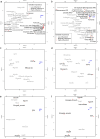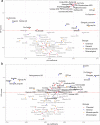Machine Learning Demonstrates Dominance of Physical Characteristics over Particle Composition in Coal Dust Toxicity
- PMID: 38186056
- PMCID: PMC10809749
- DOI: 10.1021/acs.est.3c08732
Machine Learning Demonstrates Dominance of Physical Characteristics over Particle Composition in Coal Dust Toxicity
Abstract
Mine dust has been linked to the development of pneumoconiotic diseases such as silicosis and coal workers' pneumoconiosis. Currently, it is understood that the physicochemical and mineralogical characteristics drive the toxic nature of dust particles; however, it remains unclear which parameter(s) account for the differential toxicity of coal dust. This study aims to address this issue by demonstrating the use of the partial least squares regression (PLSR) machine learning approach to compare the influence of D50 sub 10 μm coal particle characteristics against markers of cellular damage. The resulting analysis of 72 particle characteristics against cytotoxicity and lipid peroxidation reflects the power of PLSR as a tool to elucidate complex particle-cell relationships. By comparing the relative influence of each characteristic within the model, the results reflect that physical characteristics such as shape and particle roughness may have a greater impact on cytotoxicity and lipid peroxidation than composition-based parameters. These results present the first multivariate assessment of a broad-spectrum data set of coal dust characteristics using latent structures to assess the relative influence of particle characteristics on cellular damage.
Keywords: coal mine dust; cytotoxicity; oxidative stress; partial least squares regression; particle-cell relationships.
Conflict of interest statement
The authors declare no competing financial interest.
Figures




Similar articles
-
The impact of coal mine dust characteristics on pathways to respiratory harm: investigating the pneumoconiotic potency of coals.Environ Geochem Health. 2023 Oct;45(10):7363-7388. doi: 10.1007/s10653-023-01583-y. Epub 2023 May 2. Environ Geochem Health. 2023. PMID: 37131112 Free PMC article. Review.
-
Impact of reactive iron in coal mine dust on oxidant generation and epithelial lung cell viability.Sci Total Environ. 2022 Mar 1;810:152277. doi: 10.1016/j.scitotenv.2021.152277. Epub 2021 Dec 10. Sci Total Environ. 2022. PMID: 34902414
-
Characterizing patterns of small pneumoconiotic opacities on chest radiographs of New Mexico coal miners.Arch Environ Occup Health. 2022;77(4):263-267. doi: 10.1080/19338244.2021.1886035. Epub 2021 Feb 15. Arch Environ Occup Health. 2022. PMID: 33583358
-
The derivation of estimated dust exposures for U.S. coal miners working before 1970.Am Ind Hyg Assoc J. 1992 Apr;53(4):248-55. doi: 10.1080/15298669291359609. Am Ind Hyg Assoc J. 1992. PMID: 1529917
-
Coal Workers' Pneumoconiosis and Other Mining-Related Lung Disease: New Manifestations of Illness in an Age-Old Occupation.Clin Chest Med. 2020 Dec;41(4):687-696. doi: 10.1016/j.ccm.2020.08.002. Clin Chest Med. 2020. PMID: 33153687 Review.
Cited by
-
Use of electron microscopy to determine presence of coal dust in a neighborhood bordering an open-air coal terminal in Curtis Bay, Baltimore, Maryland, USA.Sci Total Environ. 2024 Dec 20;957:176842. doi: 10.1016/j.scitotenv.2024.176842. Epub 2024 Oct 11. Sci Total Environ. 2024. PMID: 39396779 Free PMC article.
References
-
- Ghose M. K.; Majee S. R. Assessment of the Impact on the Air Environment Due to Opencast Coal Mining - An Indian Case Study. Atmos. Environ. 2000, 34 (17), 2791–2796. 10.1016/S1352-2310(99)00302-7. - DOI
-
- Yadav A. K.; Jamal A. Impact of Mining on Human Health in and around Mines. Environ. Qual. Manag. 2018, 28 (1), 83–87. 10.1002/tqem.21568. - DOI
-
- Shi P.; Xing X.; Xi S.; Jing H.; Yuan J.; Fu Z.; Zhao H. Trends in Global, Regional and National Incidence of Pneumoconiosis Caused by Different Aetiologies: An Analysis from the Global Burden of Disease Study 2017. Occup. Environ. Med. 2020, 77 (6), 407–414. 10.1136/oemed-2019-106321. - DOI - PubMed
MeSH terms
Substances
LinkOut - more resources
Full Text Sources
Medical

